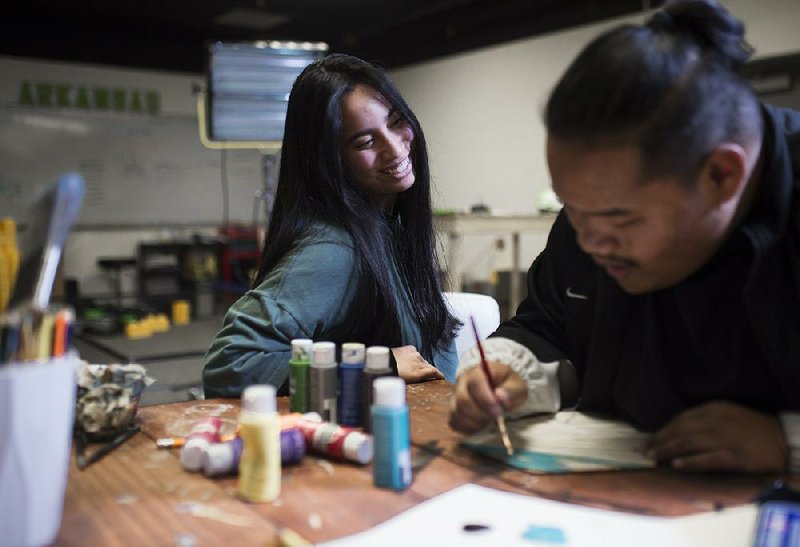Investing in diverse communities is a national trend that’s beginning to take root in Northwest Arkansas, including in the arts.
“People from diverse backgrounds enrich communities with innovative ideas and creative solutions to difficult problems, and their unique experiences enhance the talent pool of workforce available to our regional companies,” said Nelson Peacock, president and CEO of the Northwest Arkansas Council.
The arts enhance the quality of life and serve as an economic driver for the region, he said.
The investment in the arts nationally has historically gone to large organizations, rather than smaller, insular communities of color, said Allyson Esposito, executive director of a regional arts service organization launched by the Northwest Arkansas Council.
That paradigm is beginning to shift as people recognize the value of investing in the advancement and leadership within diverse communities, she said.
Her organization advocates for art and creative people in the state’s northwest. “There’s a huge opportunity to do that here.” Increasing diversity in the arts is good business for Northwest Arkansas, she said.
“There is a business imperative right around talent recruitment and talent retention,” Esposito said. “One way to do that is through cultural activities that are of, by and about the people that are coming and the people that are here.”
A case in point is the Marshallese community in Northwest Arkansas.
Joyce Hitchfield, a senior at Springdale High School, is discovering that she’s one of just a few members of the Northwest Arkansas Marshallese community exploring the American concept of art.
“There’s no real word for ‘art’” in the Marshallese language, she said.
The most comparable terms in Marshallese are “pija” or “jina,” which are defined as “drawing,” said Melisa Laelan, chief executive director and founder of the Arkansas Coalition of Marshallese.
The coalition’s goal is to improve the quality of life for the Marshallese by focusing on the pillars of education, health, cultural integrity and leadership.
What American consumers would consider art to be displayed, appreciated and potentially sold, the Marshallese traditionally view as something to do for the enjoyment of creating, she said.
The resources for traditional craft-making are nearly nonexistent for the 12,000-14,000 Marshallese who live in Northwest Arkansas, said Sheldon Riklon, an associate professor at the University of Arkansas for Medical Sciences College of Medicine in Fayetteville.
Marshallese handicrafts are woven using pandanus leaves, split and bleached young coconut palm leaves, the midrib of the coconut frond, hibiscus fibers and shells, according to the Ministry of Resources and Development with the Republic of the Marshall Islands.
The limits on traditional craft-making materials have forced Marshallese to explore new methods, Hitchfield said.
Now 18, Hitchfield immigrated to the United States from the Marshall Islands when she was 4.
She’s been making art more intentionally as she grows older and is learning to sketch and paint with watercolors.
The Teen Action and Support Center featured some of Hitchfield’s untitled sketches that were inspired by stock photos of body images in an art show this month in Spring-dale. Her biggest pieces in the show were no larger than 14-by-13.5 inches, she said.
“I felt like with drawing body parts I’d be able to express things,” Hitchfield said. “With words you can say things, but with body parts, I feel like there’s more to it.”
The images were meant to evoke feelings of vulnerability and strength, she said.
Her family has been supportive of her trying accessible art concepts, however, she appreciates the concerns of community elders who worry that younger generations will lose touch with their heritage.
“There’s a wall in front of them, and it holds them,” Hitchfield said of older people in the Marshallese community. “A lot of us younger generations, we don’t like that and are trying to overcome it.”
Peacock said the Northwest Arkansas Council is actively working to promote an inclusive environment. The nonprofit works with partners to advance Northwest Arkansas’ quality of life, improve the workforce, create job opportunities and upgrade infrastructure.
The council commissioned a study conducted by the Americans for the Arts to analyze the economic impact of nonprofit arts and cultural activities in the region, he said.
The study reported $131.2 million in total economic activity annually in Northwest Arkansas, he said. Spending included $67.5 million by nonprofit arts and cultural organizations and $63.7 million in event-related spending by their audiences.
“This spending supports nearly 5,000 full-time equivalent jobs, generates $92.9 million in household income to local residents and delivers $14.3 million in local and state government revenue,” he said.
Creating opportunities for expression also helps develop leaders capable of effecting change within Northwest Arkansas, Esposito said.
“There’s already wonderful leaders in our communities of color that maybe just need additional platforms, additional resources, additional visibility and many of them are creative people,” she said.
Developing those leaders starts with young people such as Hitchfield, who want to make changes within the Marshallese community, Laelan said.
“We want them to understand that we need future leaders,” Laelan said. “We’re empowering them to be just that.”
Hitchfield wants to be a part of the changes that art can help propel.
“I plan on putting up art pieces on climate change and global warming,” she said. “I want to express how I feel about it and how deeply sad I am about everything that’s going on.”
As climate change causes sea levels to rise and weather patterns to shift, the Marshall Islands face flooding, heat stress and drought that damages agriculture, livelihoods, homes and infrastructure, according to a brief by the International Organization for Migration.
“I hope the community will realize how big of an impact it is on our people,” Hitchfield said. “I totally think art can create a big impact on people and change how they think.”
